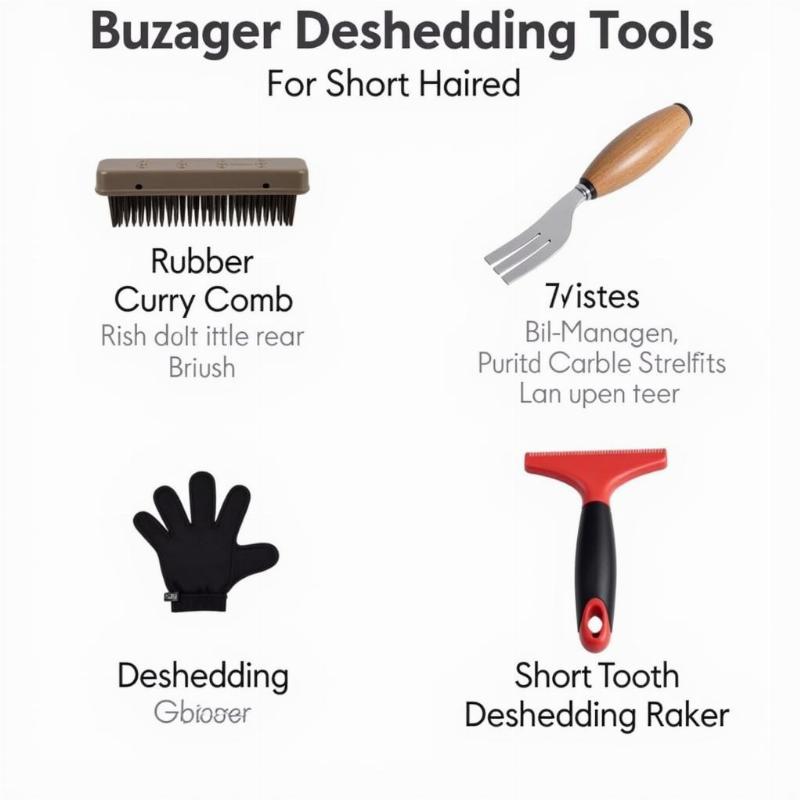Deshedding tools for short-hair dogs are essential for maintaining a clean home and a healthy pet. While it might seem counterintuitive, short-haired dogs shed just as much, if not more, than their long-haired counterparts. Finding the right deshedding tool can significantly reduce the amount of loose hair floating around your home and help maintain your dog’s coat health. This article will guide you through choosing and using the best deshedding tool for your short-haired canine companion.
Many short-haired dog owners underestimate the shedding power of their furry friends. While the individual hairs are shorter, the sheer volume can be surprising. Using a deshedding tool not only keeps your house cleaner but also helps distribute natural oils, preventing mats and promoting healthy skin. Are you tired of finding dog hair everywhere? Let’s dive into the world of deshedding tools designed specifically for short-haired breeds.
Choosing the Right Deshedding Tool for Your Short-Haired Dog
Selecting the appropriate deshedding tool depends on several factors, including your dog’s breed, coat type, and sensitivity.
- Rubber Curry Combs: These are great for removing loose hair and massaging the skin, stimulating blood circulation and promoting a healthy coat. They are generally gentle and suitable for sensitive dogs.
- Bristle Brushes: These are ideal for daily grooming and removing surface hair. Look for brushes with firm, short bristles.
- Deshedding Gloves: These gloves allow you to pet your dog while removing loose hair. They are convenient and often enjoyed by dogs who appreciate the extra attention.
- Short-Tooth Deshedding Rakes: Designed specifically for short-haired breeds, these rakes help remove dead undercoat without damaging the topcoat.
 Different deshedding tools for short hair dogs
Different deshedding tools for short hair dogs
Using Your Deshedding Tool Effectively
Once you’ve chosen the right tool, proper usage is key to maximizing its effectiveness and ensuring your dog’s comfort.
- Start Slowly: Introduce the tool gradually, allowing your dog to get used to it. Reward them with treats and praise.
- Gentle Strokes: Use short, gentle strokes in the direction of hair growth. Avoid applying too much pressure, which can irritate the skin.
- Regular Sessions: Short, frequent sessions are more effective than long, infrequent ones. Aim for a few minutes of deshedding several times a week.
- Clean the Tool: Regularly clean your deshedding tool to remove collected hair and maintain its effectiveness.
Common Mistakes to Avoid
While deshedding is beneficial, certain practices can be harmful to your dog’s coat and skin.
- Over-Deshedding: Excessive deshedding can damage the topcoat and irritate the skin. Follow the manufacturer’s instructions and avoid overdoing it.
- Using the Wrong Tool: Using a tool designed for long-haired dogs on a short-haired breed can be ineffective and potentially harmful.
- Ignoring Skin Issues: If you notice any redness, irritation, or other skin problems, consult your veterinarian.
Is a deshedding shampoo beneficial for short-haired dogs?
Yes, using a deshedding shampoo formulated for short-haired dogs can help loosen the dead undercoat and make the deshedding process more effective.
How often should I deshed my short-haired dog?
The frequency depends on the breed and individual shedding patterns. Generally, a few short sessions per week are sufficient.
Dr. Emily Carter, a renowned veterinarian in New York, emphasizes the importance of regular deshedding: “Regular deshedding not only keeps your home clean but also promotes a healthy coat and skin for your short-haired companion. It’s a simple yet crucial part of responsible pet ownership.”
undercoat deshedding tool large dog short hair
Addressing Shedding from Within
While deshedding tools are essential, a holistic approach to shedding management also involves addressing internal factors. A balanced diet rich in Omega-3 fatty acids can contribute to a healthy coat and reduce shedding. Regular vet checkups can help identify any underlying health conditions that may contribute to excessive shedding.
dog grooming center moriches ny
Conclusion
Choosing and using the right deshedding tool for your short-hair dog is crucial for maintaining both a tidy home and a healthy pet. By understanding your dog’s individual needs and following the tips outlined in this article, you can effectively manage shedding and ensure your furry friend enjoys a healthy, comfortable coat. Remember to consult with your veterinarian if you notice any skin issues or excessive shedding. Investing in a good deshedding tool is an investment in your dog’s wellbeing and your peace of mind.
FAQ
- How do I choose the right deshedding tool for my short-haired dog? Consider your dog’s breed, coat type, and sensitivity when choosing a tool.
- Can I use a deshedding tool on a puppy? Yes, but introduce the tool gently and use it sparingly.
- What are the signs of over-deshedding? Redness, irritation, or thinning of the coat are signs of over-deshedding.
- How often should I clean my deshedding tool? Clean it regularly, after each use is ideal.
- What can I do if my dog is resistant to deshedding? Start slowly, use treats and praise, and make it a positive experience.
- Are there any natural ways to reduce shedding? A balanced diet rich in Omega-3 fatty acids can help.
- When should I consult a vet about shedding? Consult your vet if you notice excessive shedding, skin irritation, or other unusual symptoms.
Beautdogs.us is your premier source for all things dog-related in the US. We offer expert advice on dog breeds, care, and the best products for your canine companion. Whether you’re a new dog owner or a seasoned pro, Beautdogs.us is your trusted resource for comprehensive, engaging, and reliable information. We connect you with the latest trends in pet care and best veterinary practices, empowering you to provide the best care for your beloved dog. Contact us for personalized guidance and support. Email: [email protected], Phone: +1 501-555-7529. Visit Beautdogs.us today!